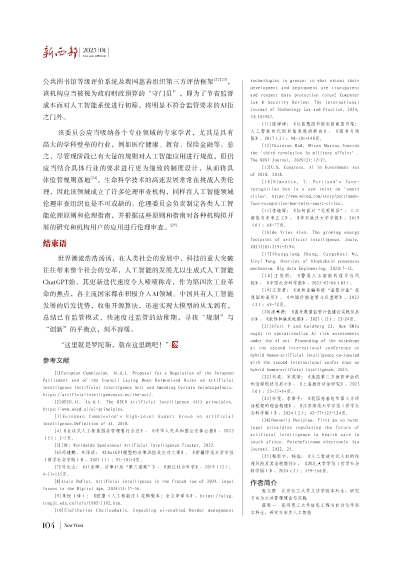欧美人工智能监管模式及政策启示
公共图书馆等级评价系统及我国慈善组织第三方评估框架[22][23],该机构应当被视为政府财政预算的“守门员”,即为了节省监督成本而对人工智能系统进行初筛,将明显不符合监管要求的AI拒之门外。
该委员会应当吸纳各个专业领域的专家学者,尤其是具有高大的学科壁垒的行业,例如医疗健康、教育、保险金融等。总之,尽管现阶段已有大量的规则对人工智能应用进行规范,但仍应当结合具体行业的要求进行更为细致的制度设计,从而将具体监管规则落地[24]。生命科学技术的高速发展常常在挑战人类伦理,因此该领域成立了许多伦理审查机构,同样在人工智能领域伦理审查组织也是不可或缺的。伦理委员会负责制定各类人工智能伦理原则和伦理指南,并根据这些原则和指南对各种机构拟开展的研究和机构用户的应用进行伦理审查。[25]
结束语
世界潮流浩浩汤汤,在人类社会的发展中,科技的重大突破往往带来整个社会的变革,人工智能的发展尤以生成式人工智能ChatGPT始,其更新迭代速度令人啧啧称奇,作为第四次工业革命的焦点,各主流国家都在积极介入AI领域。中国具有人工智能发展的后发优势,收集开源算法,迅速实现大模型的从无到有,总结已有监管模式,快速度过监管的幼稚期,寻找“规制”与“创新”的平衡点,刻不容缓。
“这里就是罗陀斯,就在这里跳吧!”
参考文献
[1]European Commission. (n.d.). Proposal for a Regulation of the EuropeanParliament and of the Council Laying Down Harmonised Rules on ArtificialIntelligence (Artificial Intelligence Act) and Amending Certain UnionLegalActs.https://artificialintelligenceact.eu/the-act/.
[2]OECD.AI. (n.d.). The OECD Artificial Intelligence (AI) principles.https://www.oecd.ai/ai-principles.
[3]European Commission's High-Level Expert Group on ArtificialIntelligence.Definition of AI, 2018.
[4]《生成式人工智能服务管理暂行办法》,《中华人民共和国公安部公报》,2023(5):2-5页。
[5]IDC:Worldwide Semiannual Artificial Intelligence Tracker. 2022.
[6]邓建鹏、朱怿成:《ChatGPT模型的法律风险及应对之策》,《新疆师范大学学报(哲学社会学版)》,2023(5):91-101+2页。
[7]马长山:《AI法律、法律AI及“第三道路”》,《浙江社会科学》,2019(12):4-11+155页。
[8]Alain Duflot. Artificial intelligence in the french law of 2024. LegalIssues in the Digital Age, 2024(1):37-56.
[9]朱悦(译):《欧盟〈人工智能法〉定稿版本:全文中译本》,https://aisg.tongji.edu.cn/info/1005/1192.htm。
[10]Eleftherios Chelioudakis. Unpacking ai-enabled border managementtechnologies in greece: to what extent theirdevelopment and deployment are transparentand respect data protection rules? ComputerLaw & Security Review: The InternationalJournal of Technology Law and Practice, 2024,53:105967.
[11]陆婷婷:《从智慧图书馆到智能图书馆:人工智能时代图书馆发展的转向》,《图书与情报》,2017(3):98-101+140页。
[12]Thornton Rod, Miron Marina.Towardsthe 'third revolution in military affairs' .The RUSI Journal, 2020(3):12-21.
[13]U.S. Congress. AI in Government Actof 2018. 2018.
[14]Simonite, T. Portland's face-recognition ban is a new twist on 'smartcities'. https://www.wired.com/story/portlands-face-recognition-ban-twist-smart-cities/.
[15]李晓辉:《如何面对“无用阶层”:人工智能与未来正义》,《华东政法大学学报》,2019(6):68-77页。
[16]de Vries Alex. The growing energyfootprint of artificial intelligence. Joule,2023(10):2191-2194.
[17]Changqiang Zhang, Cangshuai Wu,Xinyi Wang. Overview of blockchain consensusmechanism. Big data Engineering, 2020:7-12.
[18]王悠然:《警惕人工智能的误导性风险》,《中国社会科学报》,2023-03-06(03)。
[19]江翠君:《浅析金融科技“监管沙盒”在我国的适用》,《中国价格监管与反垄断》,2023(2):69-72页。
[20]庞林源:《国外数据监管沙盒建设实践及启示》,《软件和集成电路》,2023(12):22-24页。
[21]Ufert F and Goldberg ZJ. How SMEsought to operationalize AI risk assessmentsunder the AI act. Proceeding of the workshopsat the second international conference onhybrid human-artificial intelligence co-locatedwith the second international confer ence onhybrid human-artificial intelligence, 2023.
[22]刘波、宋茂荣:《美国第三方教育评估机构治理现状与启示》,《上海教育评估研究》,2023(6):53-57+64页。
[23]任雯、李景平:《我国慈善组织第三方评估框架的理论构建》,《江苏师范大学学报(哲学社会科学版)》,2024(2):42-57+123-124页。
[24]Donnelly DustyLee. First do no harm:legal principles regulating the future ofartificial intelligence in health care insouth africa. Potchefstroom electronic lawjournal, 2022, 25.
[25]程新宇、杨佳:《人工智能时代人权的伦理风险及其治理路径》,《湖北大学学报(哲学社会科学版)》,2024(3):159-166页。
作者简介
张文康 北京化工大学文法学院本科生,研究方向为公共管理理论与实践
薛周一 昆明理工大学信息工程与自动化学院本科生,研究方向为人工智能
该委员会应当吸纳各个专业领域的专家学者,尤其是具有高大的学科壁垒的行业,例如医疗健康、教育、保险金融等。总之,尽管现阶段已有大量的规则对人工智能应用进行规范,但仍应当结合具体行业的要求进行更为细致的制度设计,从而将具体监管规则落地[24]。生命科学技术的高速发展常常在挑战人类伦理,因此该领域成立了许多伦理审查机构,同样在人工智能领域伦理审查组织也是不可或缺的。伦理委员会负责制定各类人工智能伦理原则和伦理指南,并根据这些原则和指南对各种机构拟开展的研究和机构用户的应用进行伦理审查。[25]
结束语
世界潮流浩浩汤汤,在人类社会的发展中,科技的重大突破往往带来整个社会的变革,人工智能的发展尤以生成式人工智能ChatGPT始,其更新迭代速度令人啧啧称奇,作为第四次工业革命的焦点,各主流国家都在积极介入AI领域。中国具有人工智能发展的后发优势,收集开源算法,迅速实现大模型的从无到有,总结已有监管模式,快速度过监管的幼稚期,寻找“规制”与“创新”的平衡点,刻不容缓。
“这里就是罗陀斯,就在这里跳吧!”
参考文献
[1]European Commission. (n.d.). Proposal for a Regulation of the EuropeanParliament and of the Council Laying Down Harmonised Rules on ArtificialIntelligence (Artificial Intelligence Act) and Amending Certain UnionLegalActs.https://artificialintelligenceact.eu/the-act/.
[2]OECD.AI. (n.d.). The OECD Artificial Intelligence (AI) principles.https://www.oecd.ai/ai-principles.
[3]European Commission's High-Level Expert Group on ArtificialIntelligence.Definition of AI, 2018.
[4]《生成式人工智能服务管理暂行办法》,《中华人民共和国公安部公报》,2023(5):2-5页。
[5]IDC:Worldwide Semiannual Artificial Intelligence Tracker. 2022.
[6]邓建鹏、朱怿成:《ChatGPT模型的法律风险及应对之策》,《新疆师范大学学报(哲学社会学版)》,2023(5):91-101+2页。
[7]马长山:《AI法律、法律AI及“第三道路”》,《浙江社会科学》,2019(12):4-11+155页。
[8]Alain Duflot. Artificial intelligence in the french law of 2024. LegalIssues in the Digital Age, 2024(1):37-56.
[9]朱悦(译):《欧盟〈人工智能法〉定稿版本:全文中译本》,https://aisg.tongji.edu.cn/info/1005/1192.htm。
[10]Eleftherios Chelioudakis. Unpacking ai-enabled border managementtechnologies in greece: to what extent theirdevelopment and deployment are transparentand respect data protection rules? ComputerLaw & Security Review: The InternationalJournal of Technology Law and Practice, 2024,53:105967.
[11]陆婷婷:《从智慧图书馆到智能图书馆:人工智能时代图书馆发展的转向》,《图书与情报》,2017(3):98-101+140页。
[12]Thornton Rod, Miron Marina.Towardsthe 'third revolution in military affairs' .The RUSI Journal, 2020(3):12-21.
[13]U.S. Congress. AI in Government Actof 2018. 2018.
[14]Simonite, T. Portland's face-recognition ban is a new twist on 'smartcities'. https://www.wired.com/story/portlands-face-recognition-ban-twist-smart-cities/.
[15]李晓辉:《如何面对“无用阶层”:人工智能与未来正义》,《华东政法大学学报》,2019(6):68-77页。
[16]de Vries Alex. The growing energyfootprint of artificial intelligence. Joule,2023(10):2191-2194.
[17]Changqiang Zhang, Cangshuai Wu,Xinyi Wang. Overview of blockchain consensusmechanism. Big data Engineering, 2020:7-12.
[18]王悠然:《警惕人工智能的误导性风险》,《中国社会科学报》,2023-03-06(03)。
[19]江翠君:《浅析金融科技“监管沙盒”在我国的适用》,《中国价格监管与反垄断》,2023(2):69-72页。
[20]庞林源:《国外数据监管沙盒建设实践及启示》,《软件和集成电路》,2023(12):22-24页。
[21]Ufert F and Goldberg ZJ. How SMEsought to operationalize AI risk assessmentsunder the AI act. Proceeding of the workshopsat the second international conference onhybrid human-artificial intelligence co-locatedwith the second international confer ence onhybrid human-artificial intelligence, 2023.
[22]刘波、宋茂荣:《美国第三方教育评估机构治理现状与启示》,《上海教育评估研究》,2023(6):53-57+64页。
[23]任雯、李景平:《我国慈善组织第三方评估框架的理论构建》,《江苏师范大学学报(哲学社会科学版)》,2024(2):42-57+123-124页。
[24]Donnelly DustyLee. First do no harm:legal principles regulating the future ofartificial intelligence in health care insouth africa. Potchefstroom electronic lawjournal, 2022, 25.
[25]程新宇、杨佳:《人工智能时代人权的伦理风险及其治理路径》,《湖北大学学报(哲学社会科学版)》,2024(3):159-166页。
作者简介
张文康 北京化工大学文法学院本科生,研究方向为公共管理理论与实践
薛周一 昆明理工大学信息工程与自动化学院本科生,研究方向为人工智能
